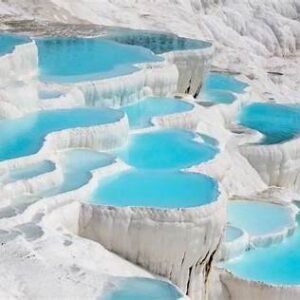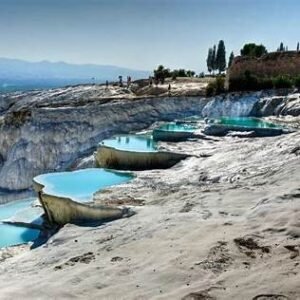



In 2025, Turkey remains one of the world’s most beguiling travel destinations. It is a land where history meets nature at every turn, where ancient empires’ ruins rest in the shade of pine forests, where turquoise seas lap the foot of arid cliffs, and where modern life pulses through bazaars in cities that span continents. Walking through Turkey is like stepping through layers of time: Byzantium, Hittite, Roman, Seljuk, Ottoman — all overlapping, overlapping again.
The Most Beautiful Places to Visit in Turkey 2025 is more than a list; it’s an invitation to discover how the land and its people have shaped one another. In this article, I will lead you through the country’s greatest spectacles — natural and manmade — weaving stories of civilization, myth, geology, and human aspiration. You’ll find both the famous and the lesser known, and enough factual depth to seed further study for explorers, scholars, or armchair travelers.
1. Istanbul: The City of Two Continents
1.1 A City Between Worlds
Few places in the world embody the collision of eras and geographies as clearly as Istanbul. Straddling both Europe and Asia, the city is a living palimpsest of empires. Walking through its neighborhoods, one senses Byzantine churches, Ottoman mosques, Roman walls, and modern cafés all breathing together.
From the moment the boat glides into the Bosphorus at dawn, with seagulls and minarets outlined against pastel skies, you feel that you are not just arriving in a city but embarking on a voyage through time.
1.2 Highlights: Hagia Sophia, Topkapi, Blue Mosque
No other building in Istanbul so clearly evokes the spiritual and political transitions of the city as Hagia Sophia. Built in the 6th century under Emperor Justinian, it was the world’s largest cathedral for centuries. In 1453, it was converted into a mosque by Mehmed II, and more recently functions as a museum (and occasionally a place of worship). The interplay of Christian mosaics and Islamic calligraphy encapsulates the cultural layering of the city.
Nearby is the Blue Mosque (Sultanahmet Mosque), famed for its six minarets and its interior lined with delicate İznik tiles in shades of blue. It is still a functioning mosque and one of Istanbul’s iconic architectural landmarks. Also essential is Topkapi Palace, the seat of Ottoman sultans for centuries, with its treasury, harem quarters, gardens, and commanding views over the Golden Horn.
Beyond the major sites, wander the alleys of Sultanahmet, cross the Galata Bridge, ride a ferry along the Bosphorus to the Asian shore’s neighborhoods like Kadıköy or Üsküdar, and visit the Grand Bazaar and Spice Bazaar for a swirl of commerce, smells, and color.
1.3 Nature in the City
Though Istanbul is dense and historic, nature is never far. The shores of the Bosphorus, lined with yalı mansions, parks, and ferry landings, give constant glimpses of water and greenery. The Princes’ Islands (Büyükada, Heybeliada, etc.) are a short ferry ride away — a quiet respite from the city, with pine forests, old Ottoman houses, and no motor vehicles (bikes and horse-carriages dominate).
In short, Istanbul incarnates the very idea of “where history meets nature” — a living city shaped by rivers and seas as much as by walls and palaces.
2. Cappadocia & Göreme: Rock Firelands & Underground Worlds
One of the first places that springs to mind for “Most Beautiful Places to Visit in Turkey 2025,” Cappadocia is almost otherworldly.
2.1 The Geology of Imagination
Cappadocia’s landscapes were carved over millennia by volcanic ash, wind, and erosion. The result: soft rock (tuff) sculpted into conical “fairy chimneys,” spires, hoodoos, valleys with undulating ridges, and caves. These natural formations have given the region its fairy-tale appearance.
The atmospheric drama is intensified at sunrise, when countless hot air balloons rise into the dawn sky, casting long shadows over valleys of pink, ochre, and pale grey. It’s one of Turkey’s signature visual experiences, often featured on travel postcards.
2.2 Göreme Open-Air Museum & Rock Churches
Cappadocia is also rich in human history. The Göreme Open-Air Museum, a UNESCO World Heritage site, preserves rock-hewn churches, chapels, and monasteries with Byzantine frescoes dating from the 10th to the 13th centuries. Pilgrims and monks carved sanctuaries into soft rock, leaving us a luminous record of early Christian devotion.
In valleys like Rose Valley, Pigeon Valley, Love Valley, and Red Valley, hikers find hidden cave chapels, hermit dwellings, and scenic views. Many rock-chambered churches are hidden away, their walls still bearing frescoes of saints, angels, and biblical scenes.
2.3 Underground Cities
Below the surface lies another layer of Cappadocia’s mystery. Complex subterranean cities like Derinkuyu and Kaymaklı were carved to shelter whole populations during times of threat. Narrow tunnels connect chambers for sleeping, grain storage, wine pressing, and ventilation shafts. In times of war, communities withdrew underground, sometimes sheltering thousands for days. Walking those tunnels, you feel the shadow of ancient refuge.
2.4 Uçhisar, Ortahisar & Beyond
At the edge of the valleys, Uçhisar Castle (a rock fortress) offers views across Cappadocia’s panorama. In Ortahisar, you’ll find a quieter blend of village life with rock houses and local crafts. Sunrise and sunset hikes around Pigeon Valley or Rose Valley are unforgettable: light plays on the soft rock, deep shadows and color contrasts emerge, and you sense how nature sculpted not just land but human imagination.
3. Pamukkale & Hierapolis: The Cotton Castle and Sacred Springs
Moving westward, one of Turkey’s most famous natural wonders is Pamukkale, often translated as “Cotton Castle.” It is here that geology, hydrology, and ancient civilization converge in startling beauty.
3.1 The Terraces of Pamukkale
Pamukkale’s white travertine terraces are formed by thermal spring waters rich in calcium carbonate. As water flows and cools, it deposits mineral layers that create solid white cascades, pools, and ridges. To look upon them is to see a landscape that seems half-mythical, half-earthly, like frozen waterfalls of snow.
Visitors may walk barefoot along designated paths where water trickles over the terraces, though certain zones are restricted to protect the formation. The contrast of stark white terraces against blue pools and green landscape is a visual masterpiece.
3.2 Hierapolis: The Ancient Spa City
Above these terraces lies the ancient city of Hierapolis, founded in the Hellenistic period. Romans and Byzantines treated this site as a healing resort, drawn to its thermal waters. The ruins include a well-preserved Roman theatre, a necropolis (one of Turkey’s largest ancient cemeteries), colonnaded streets, baths, and the Plutonium (a cave once considered an underworld entrance).
Walking through Hierapolis, you sense the interplay: people centuries ago built around and with these springs, making temples and baths that respected the natural power beneath.
3.3 Cleopatra’s Pool
One particularly enchanting site is Cleopatra’s Pool, an ancient thermal pond where submerged columns lie beneath warm waters. Legend says that Cleopatra swam here — whether historically accurate or not, the ambiance is romantic. You can swim among the partially submerged ruins, with fish darting past column pieces and marble fragments.
4. Ephesus: Mystery in Marble and Stone
If Cappadocia is nature’s drama, Ephesus is history’s whisper — the city where marble colonnades, mosaic floors, and poetic ruins conjure the passage of empires.
4.1 The Glory of Ephesus
Ephesus, on Turkey’s Aegean coast, was one of the largest Roman cities in the Mediterranean and an important center in antiquity. The Library of Celsus — its façade still rising from the ruins — is among the most emblematic structures of antiquity. Walk beyond and you find a vast Great Theatre, once seating 25,000 spectators, where music, drama, and politics fused.
Other structures: the Temple of Hadrian, Terrace Houses (luxury residences with intricate frescoes), the Odeon, and wide colonnaded streets. The scale and craftsmanship still amaze.
4.2 The Temple of Artemis & House of the Virgin Mary
Nearby lies the site of the Temple of Artemis, once considered one of the Seven Wonders of the Ancient World (though little remains). For Christian and Catholic pilgrims, the House of the Virgin Mary— believed to be where Mary lived her final years — is a quiet, sacred place of prayer and reflection.
4.3 Ephesus in Context
As you wander Ephesus, you can imagine merchants, philosophers, and pilgrims weaving through the same marble streets. The conservation efforts are remarkable: some mosaics beneath protective shelters, restoration of facades, signage in multiple languages to help visitors understand the layers of history.
For many travelers, Ephesus is a highlight in The Most Beautiful Places to Visit in Turkey 2025 — a place where stone and story combine.
5. Antalya and the Turquoise Coast: Sea, Cliffs & Roman Legacies
No survey of Turkey’s beauty is complete without the turquoise waters and dramatic coastline of Antalya province.
5.1 Kaleiçi & Old Antalya
Start in Antalya itself, particularly the old quarter known as Kaleiçi. Winding alleys, old Ottoman houses, fountains, mosques, and a restored city gate (Hadrian’s Gate) evoke the city’s layered past. The old harbor, with yachts bobbing against stone piers, is a scenic center for evening strolls.
5.2 The Beaches & Blue Voyage
Beyond the city, the Turquoise Coast is lined with coves, bays, and ancient harbor towns. The coast is dotted with Lycian, Roman, and Ottoman ruins. Charter a traditional gulet (wooden boat) and cruise from cove to cove, anchoring near hidden bays, swimming in clear water, and exploring coastal ruins. This kind of “Blue Voyage” is a signature Mediterranean experience in Turkey.
Key beach towns include Kaş, Kalkan, Demre, Patara, and Olympos. Patara Beach is also home to Lycian ruins and a long sandy stretch. Olympos blends historic ruins with treehouses in forested hills near the sea.
5.3 Aspendos, Perge & Termessos
For history amid nature, visit the Roman theater of Aspendos, famed for its preservation and acoustics. Nearby is Perge, with its colonnaded streets, baths, and stadium. Further inland lies Termessos — perched high in the Taurus Mountains, accessible only by hiking — offering ruins in forested heights and spectacular views below.
5.4 Waterfalls & Mountains
Antalya province also hosts the Düden Waterfalls just outside the city, and the Kurşunlu Waterfall Nature Park. In the mountains behind the coast, pine forests, hidden streams, and quiet villages offer respite from the sunshine and crowds.
6. Fethiye, Ölüdeniz & Butterfly Valley: Coastal Beauty and Wild Valleys
Further along the southwestern coast, the Fethiye region combines sea, mountains, and ancient ruins in spectacular fashion.
6.1 Ölüdeniz & the Blue Lagoon
The beach of Ölüdeniz, often called the “Blue Lagoon,” is among Turkey’s most photographed spots. The calm, shallow bay with its vivid blues and greens (backed by forested slopes) feels like an aquatic oasis. It is ideal for swimming, paddleboarding, or just floating in the limpid water.
6.2 Butterfly Valley (Kelebekler Vadisi)
Accessible by boat or by hiking (for adventurous travelers), Butterfly Valley is a narrow canyon opening to the Mediterranean, with steep walls, a wild creek, and a sandy beach at the mouth. Its name comes from the many butterfly species found there — in summer you may see dozens fluttering among shrubs and rocky slopes. Wikipedia
Camping is allowed (in limited, regulated fashion), and there are basic facilities, making it a favored spot for nature lovers seeking serenity. Wikipedia
6.3 Saklıkent Gorge & Canyon
Just inland, Saklıkent National Park is a deep canyon carved by water over millennia. The gorge reaches depths of 300 meters and runs for over 18 km, though only the first few kilometers are typically traversable by casual visitors. Trekking through icy water, walking on wooden walkways, and scrambling across rocks — it’s an adventurous contrast to the calm seascapes. Wikipedia
6.4 Lycia’s Tombs & Ghost Villages
In Fethiye itself, the Tomb of Amyntas (4th century BC Lycian rock tomb carved high in the cliffs above the town) is a haunting silhouette at sunset. Wikipedia
Also nearby is the ghost village of Kayaköy, once a Greek village abandoned in the early 20th century. Ruined stone houses lie silent on hillside terraces, a poignant reminder of population shifts and cultural histories. Wikipedia
Boat tours from Fethiye often include stops at the island of Kızılada, underwater ruins near Afkule, and secluded bays.
7. The Black Sea Edge: Trabzon, Sumela, and Hamsilos Bay
Turkey’s Black Sea region is often overlooked by travelers favoring the south, but it offers a misty, green contrast: cliffs, fog, forests, waterfalls, and hidden monasteries.
7.1 Trabzon & the Pontic Heritage
The city of Trabzon, in northeastern Turkey, was historically part of the Byzantine “Empire of Trebizond.” It became a major Silk Road juncture, a melting place of cultures. The city’s architecture blends Byzantine, Georgian, and Ottoman influences.
7.2 Sumela Monastery
One of the strongest images of the Turkish Black Sea is Sumela Monastery, perched on a steep cliff face in the Altındere valley. Founded around 386 CE, it became a center of Eastern Orthodox monasticism. The monastery’s structure — built into the rock, extended over centuries — houses chapels, frescoed rooms, and cliffside walkways. Wikipedia
Visiting Sumela feels like entering a secret world: the valley fog, towering cliffs, shaded forest, and winding path all add to the sacred hush. It is one of Turkey’s most spectacular “history meets nature” sites.
7.3 Hamsilos Bay: Turkey’s “Fjord”
Near the northern tip of the country lies Hamsilos Bay (Sinop Province). Though not a true fjord, locals liken its shape to one — forested shores plunge into narrow blue waters, giving a dramatic impression of depth and enclosure. Wikipedia
Declared a nature park in 2007, the bay is a quieter, less-traveled gem, ideal for contemplative walks or boat rides. Wikipedia
7.4 Other Black Sea Highlights
Along the Black Sea coast one will find steep coastline alternated with lush valleys, tea plantations, and mountain villages. The misty climate nurtures moss, ferns, and temperate forest, and waterfalls often cascade roadside. The region’s ambiance is very different — cooler air, deeper greens, and a slower pace.
8. Eastern Wonders: Mount Nemrut, Göbekli Tepe, Hasankeyf & Mardin
Turkey’s east often demands effort and longer travel, but it rewards with ancient mysteries, rugged vistas, and cultural crossroads.
8.1 Mount Nemrut: Thrones Among the Clouds
Rising above the plain of Commagene, Mount Nemrut (Nemrut Dağı) features colossal stone heads and statues arrayed around burial mounds of King Antiochus I (1st century BC). At sunrise and sunset, light plays dramatically across the faces of gods and kings, their broken fragments scattered across the mountaintop. The surreal vista is haunting — as though deities were frozen mid-conversation. The Guardian
Hiking up the terraces, visiting both East and West terraces, and watching the sunrise is one of Turkey’s iconic pilgrimages.
8.2 Göbekli Tepe: The Oldest Temple
Göbekli Tepe, located in southeastern Turkey, is arguably one of the world’s most important recent archaeological discoveries. Dated to ~9600–8000 BCE, its megalithic enclosures predate Stonehenge by millennia. Circular stone pillars, some carved in animal reliefs, suggest ritual activity before organized agriculture. It reshapes our understanding of prehistoric human society.
Visiting Göbekli Tepe is traveling even beyond known history — the site is still being excavated and researched, but visitors can walk among the partially unearthed enclosures and experience the silent power of early sacred architecture.
8.3 Hasankeyf: The Ancient River Town
Hasankeyf, an ancient town on the Tigris, has been in the news due to dam projects and threatened inundation. It contains caves, rock tombs, medieval bridges, and ruins tracing back centuries. Though parts of Hasankeyf are now underwater or being relocated, the remnants and ongoing story make it a poignant place where nature and history converge under threat.
8.4 Mardin: Stone, Memory & Horizon
Perched above the Mesopotamian plain, Mardin is an architectural harmony of stone terraces, narrow alleys, mosques, madrasas, and terraces that look toward the vast plain beyond. The whispers of Assyrian, Kurdish, Arab, Armenian, Syriac, and Ottoman histories converge. Walking Mardin feels like strolling through a medieval memory, with the horizon stretching far toward Syria and the heartland.
9. Unique Natural Gems: Lake Salda, Kaş, Dalyan & Hidden Spots
Beyond the “big names,” Turkey hides wonders waiting to surprise intrepid travelers. In 2025, some of these are increasingly on the map — but still feel intimate.
9.1 Lake Salda: The “Turkish Maldives”
Lake Salda (Salda Gölü) in southwestern Turkey has gained attention for its crystal-clear turquoise water, white sandy shores, and resemblance to the Maldives. Its high alkaline composition and deep basin make it unusually clean and striking. The Sun
Some shores are protected, so swimming is restricted to designated areas, but viscerally the visual is breathtaking: white shores, forested hills, blue water, and silence.
9.2 Kaş & Patara: Lycian Heritage by the Sea
The Aegean town of Kaş is a favorite among divers, with underwater ruins, sea caves, and coastal walks. Just east lies Patara, a long sandy beach backed by dunes and adjacent to extensive Lycian ruins: a theatre, a parliament building, and tombs. The juxtaposition of sea, drifting dunes, and ruins is sublime.
9.3 Dalyan & the Delta of Rivers
In the Dalyan area, the Iztuzu Beach (Turtle Beach) is famous as a nesting ground for loggerhead sea turtles (Caretta caretta). Take a boat ride on the Dalyan River through reed banks, past Lycian rock tombs carved on cliffs, and toward thermal mud baths. The area is natural and cultural, quiet and alive.
9.4 Hidden Valleys, Quiet Plateaus & Rural Trails
Turkey is full of lesser known escapes: plateau villages in the Taurus or Kaçkar mountains, remote valleys in the east, high meadows (yaylas) with shepherds, and small bays away from highways. Part of the joy in 2025 is seeking less-traveled trails: where a shepherd’s dog might greet you, and you descend to a hidden ruin beside a stream.
10. Practical Notes: Best Time, Itineraries, Travel Tips
10.1 Best Time to Visit
The ideal periods are spring (April to June) and autumn (September to October). In these months, the weather is mild, daylight generous, and many places enjoy fewer crowds. Summer (July–August) can be very hot on the coast and abrupt in interior regions; winter is cold and snowy in eastern or mountainous zones.
10.2 Suggested Itineraries
-
Two-week classic: Istanbul → Cappadocia → Pamukkale → Ephesus → Antalya → Fethiye → return
-
Three-week deeper version: Add eastern leg: Nemrut, Göbekli Tepe, Hasankeyf, Mardin
-
Coastal & nature focus: Antalya → Kaş → Fethiye → Dalyan → Patara → Ölüdeniz → Butterfly Valley
-
Northern & Black Sea: Istanbul → Black Sea coast → Trabzon → Sumela → Hamsilos → back
Flexibility is key: allow days for rest, off-schedule discoveries, and travel slack.
10.3 Travel & Transport
Turkey is well served by domestic flights (Istanbul as hub, plus to Cappadocia, Antalya, Izmir, etc.). Buses and overnight coaches cover long-distance land routes. Trains (especially high-speed) connect major cities (e.g. Istanbul to Ankara to Konya). Car rental or private transfers are useful for reaching more remote sites.
Guided local tours often help in places where signage is sparse (especially in eastern or rural regions). For sites like Göbekli Tepe, Sumela, or Nemrut, a guided interpretation enhances the experience.
10.4 Accommodation, Permits & Fees
Many of the famous places have well-developed infrastructure: hotels, boutique guesthouses, cave hotels (in Cappadocia), seaside pensions, etc. In more remote zones, guesthouses or eco-lodges may be the only options.
Some protected sites or nature reserves require entrance fees or time restrictions. For example, walking on certain terraces in Pamukkale is regulated to protect the formations. Some zones in Göreme Open-Air Museum, Sumela, and Eastern ruins have restricted access for conservation. Always check local boards and follow rules.
10.5 Cultural & Practical Etiquette
-
Dress modestly in religious sites (cover shoulders, no shorts in mosques).
-
Respect signage: don’t climb fragile ruins or cross into off-limits zones.
-
In rural areas, simple greetings (Merhaba, Selam) go far.
-
Be sensitive in regions with cultural or political complexities (especially in eastern Turkey).
-
Hydrate, carry sun protection, and pace yourself — Turkey’s landscapes often invite more walking than one expects.
11. Epilogue: Why Turkey Remains an Odyssey
As we look across The Most Beautiful Places to Visit in Turkey 2025, a common thread weaves though: the interplay of human agency and nature’s power. Empires built theaters on cliffs. Monasteries carved into rock faces. Springs shaped terraces. Rivers carved tunnels. Time layered all of it.
To visit Turkey is to see how geography shapes the human story, and how human culture, in turn, reveres and adapts to the land. It is a journey into the deep dialogues between stone, wind, water, and devotion.
If you’d like, I can create a shorter travel-guide version (with maps, budget tips, photo galleries) or convert this into a multi-part series. Also: you may enjoy reading more about another region — for example, check out this internal link on Brazil travel: https://jetsettrail.com/best-places-to-visit-in-brazil-beaches-cities-amazon-adventures-2025/


